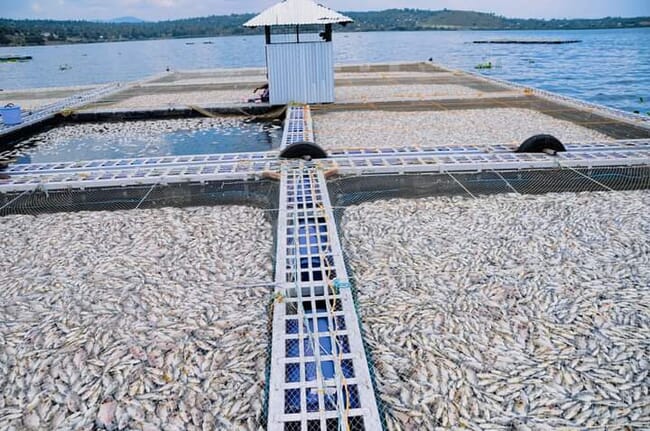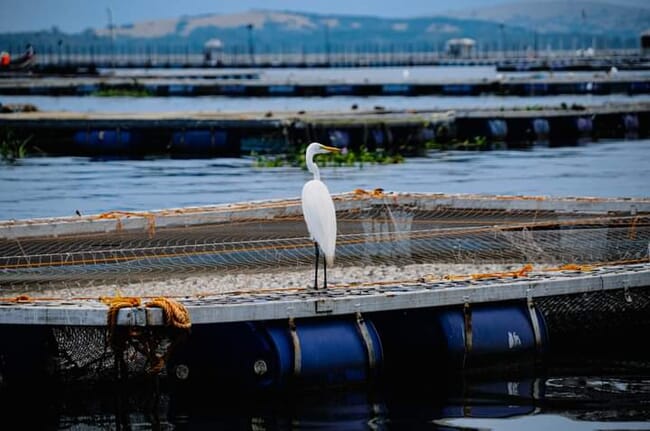
The mortalities began in September and have continued into November, particularly in Kisumu County, Kenya © Paul Cage Fish Farmers Group
The mortality incidents started in September and continued into November, particularly in Kisumu County. 364 million fish are believed to have died according to one news agency, while the total financial loss is estimated to be more than 1.4 billion Kenyan shillings ($11.4 million).
Many farmers had no idea what caused the fish kills – some blamed industrial effluent and raw sewage discharge around Kisumu town. However, according to Kenya Marine and Fisheries Research Institute (KMFRI), upwelling was the cause of the fish kills – with water temperatures reaching 28°C, oxygen levels dropping below 3 mg/L and an increase in suspended sediments.
“Upwelling, which leads to an increased nutrient enrichment (intrinsic and extrinsic), has led to increased algal blooms and water hyacinth populations in the lake which are decomposing rapidly, causing the oxygen content of the water to decrease. It’s a natural phenomenon that occurs when dense, cool nutrient-rich water that is deoxygenated due to increased decomposition from the bottom of the water column offshore replaces the nutrient depleted surface water in the nearshore and causes suffocation of fish,” said Dr Christopher Aura, director fresh water systems at KMFRI.

Upwelling was the cause of the fish kills – with water temperatures reaching 28°C, oxygen levels dropping below 3 mg/L and an increase in suspended sediments making it difficult for the fish to survive © Shamba Nixon Cage Fish Farmers Group
He also added that many of the affected farmers hadn’t been following best aquaculture practices: some go way beyond the recommended stocking densities, use poor quality feed and use prohibited antibiotics.
The institution is currently raising awareness of upwelling and mitigation measures and advises farmers to move cages to deeper waters and buy water quality kits for measuring dissolved oxygen levels.
Safina Musa, a research scientist at KMFRI in Kisii County, stated that the regions of the lake affected include Ogal, Asat, Kobutho and Achuodho beaches and warned the farmers not throw rotten fish back into the lake as this will only worsen the situation.
Mixed reactions from farmers
Stephen Ogal, the founder and CEO of Alachi Riat Aqua-fish Group in Migori County, lost all of his 7,000 fish from a 6m x 6m x 7m cage. However, he is optimistic and has already restocked 2,000 fingerlings in the affected cage.
“I do not think the fish will die again because the other cages were not affected, I have restocked to try and recover the loss I experienced and have been observing the fish,” he said.
He also pleaded with the government to provide support to the affected cage farmers.
“We are only requesting the county government to give us support in terms of donating fingerlings to recover the losses we have experienced in the past few weeks,” he added.
Ogal established his cage farming business in 2018 with a 1.5 million KES ($12,000) grant received from the Israeli Embassy, which was spent on purchasing cage materials and other inputs to start the business. He currently owns a total of five cages. His four other cages (dimensions 5m x 5m x 4m) were not affected and currently have 5,000 fish each.
Anthony Mckayany, the secretary general of the Cage Farmers Association of Kenya, also owns cages in the lake but was not personally affected.

Some farms have experienced minimal losses, while others have been devastated © Shalton Cage Fish Farmers Group
“The first mistake came from the farmers themselves as they did not understand what business they were getting into and therefore did not adopt best management practices including expert consultation, site selection, stocking density, type of feed etc,” he argues.
He said that the first case that happened in Dunga beach two months ago and results indicated that it was the farmers’ management practices that were responsible, because the area’s wild fish were not dying. Mckayany also added that some farmers had been advised to remove cages from shallow areas of the lake because of seasonal upwelling, but they disregarded the directive.
Paul Okech, chairperson of Gwend Nyadhi farmers’ cooperative SACCO Ltd, said: “The majority of the affected areas are within Kisumu County. We have members across Migori, Homabay and Siaya, but Kisumu County was largely affected. My family has invested in cage farming, but we are not affected in our location so far.”
Victory Farms, one of the leading producers of tilapia in the region, were not affected by the incident.
“Our farm was not affected at all; the lake is big and it could be because of the cage siting. Our cages are located in Sindo, while most farmers who lost their fish are located in Rachuonyo,” said Caesar Asiyo, chief development officer at Victory Farms.
Fred Obudho, CEO of Greatlakes Feeds, said: “15 of our customers were affected and lost 45 tonnes of fish, prompting some farmers to take a break from stocking altogether.”
Call for political support
Okech urged the local members of parliament and the county assembly to engage with the various fish farmers’ associations, as he feels that the local politicians have not taken fish farming as a serious business in the way the leadership in Central province and Rift valley takes care of milk and tea in their regions respectively.
“These other leaders go out of their way to make sure that the policies and legislative frameworks are very clear and they're supportive of the initiatives of their people,” he says.

The mortalities have had a knock-on effect for fish feed suppliers, fish sellers and consumers © Shamba Nixon Cage Fish Farmers Group
The mortalities have had a knock-on effect for fish feed suppliers, fish sellers and consumers. There has been confusion and panic, prompting some farmers who had not yet been affected to prematurely harvest their fish, which put a strain on the limited capacity of cold storage units in the region and logistical challenges. However, the government then gave orders for all the fish to be taken out of cold storage units and buried to avoid any transfer of pathogens.
There has been support from the government and private sector to help the affected fish farmers in the area. On 9 November, Kisumu Governor, Professor Anyang Nyong’o, issued a press statement where he said they will procure fingerlings worth 2 million KES ($16,000) and fish feed worth 1 million KES ($8,000) to be distributed to the affected fish farmers to help them restock and recover the loses. The governor stated that they will conduct a multi-stakeholders approach to address pollution and conduct an assessment of the capacity of the lake in regard to siting (location) of cage installation and compliance with set guidelines on the proper siting of cages. He urged the farmers to consider restocking the lake with indigenous species through a targeted breeding programme.
Great Lakes Feeds visited some of their clients who were affected and offered them 5,000 fingerlings for free to compensate for their losses. Victory Farms have also pledged support, stating: “As leaders in cage fish farming, we sympathise and appreciate that the farmers’ losses translate into lost dreams, lost incomes, food and nutrition insecurity and many other losses along the value chain. We are working with the leadership of HomaBay County BMUs [beach management units] and County Government, where Victory Farms will donate 175,000 fingerlings to the affected farmers.”

Despite most cage farmers believing that pollution or foul play was behind the fish kills, tests indicate that the mortalities have been related to upwellings © Shamba Nixon Cage Fish Farmers Group
Conclusion
Despite most cage farmers believing that pollution or foul play was behind the fish kills, tests indicate that the mortalities have been related to upwellings and exacerbated by poor siting and management of certain farms.
The incidents show that cage fish farmers need training in water quality evaluation. Meanwhile the government should also enforce strict policies on the siting of farms and there needs to be further development of cold storage and value addition units to support the growth of the industry.




